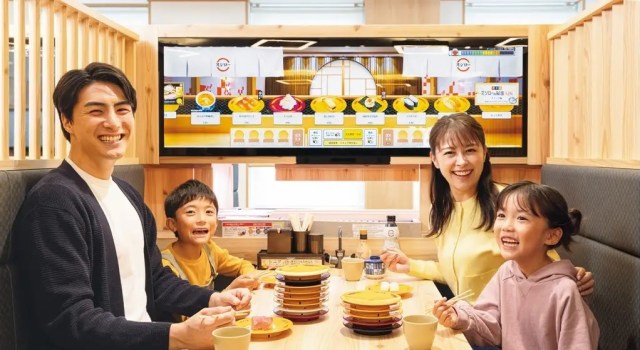
Digital Sushiro Vision seeks to recreate the fun of old-school kaitenzushi with modern technology.
Japan’s conveyor belt sushi restaurants (or kaitzenzushi restaurants, as they’re called in Japanese) are at a bit of an identity crossroads. Making up a whole bunch of plates of sushi ahead of time and putting them on the belt in hopes that customers will buy them all creates a significant food loss risk for the restaurant, what with raw fish’s short shelf life. Meanwhile, from the customer’s standpoint, it can be frustrating if the chefs aren’t making a batch of the particular type of sushi you’re in the mood for, and even if they are, you can usually order it directly instead of taking a plate off the belt, which usually gets you a fresher piece.
Because of that, in recent years, conveyor belt sushi restaurants have been putting fewer and fewer plates of sushi on the up-for-grabs conveyor, and instead most diners order the plates they want through a tablet at their table, with their sushi being whisked right to them on an express lane belt once it’s ready. However, there’s still an undeniable appeal to sitting down in a kaitenzushi joint with no prior plan, watching yet-unclaimed sushi drifting by, and grabbing something that’s only sparked your cravings once you’ve seen it.
So the question becomes how do restaurants keep the spontaneity and fun of plates going around the restaurant while maximizing freshness and minimizing food waste? Kaitenzushi chain Sushiro has an idea, and it calls it Digital Sushiro Vision.
In Japanese, the word “vision” often gets used to describe the giant video monitors found on the sides of skyscrapers, like with Tokyo’s Cross Shinjuku Vision. Digital Sushiro Vision is using “vision” in this sense, putting extra-wide monitors across the tops of its booths.
These monitors are touch screens, acting as replacements for the iPad-size tablets kaitenzushi tables are commonly equipped with these days. What’s more, the Digital Sushiro Vision monitor images are animated, with a procession of sushi plates creating a virtual version of a packed old-school kaitenzushi conveyor.
The aim is to recreate that sense of “Oh, I wasn’t thinking about that kind of sushi, but it looks great!”, sparking your memory of an old favorite or enticing you to try something new based on how it looks.
That doesn’t mean you’re locked into only ordering the virtually drifting items, though, as you can use the Digital Sushiro Vision to order whatever you’d like. Another nice feature is that it can register input taps from two users simultaneously, which should also make ordering a little smoother than having everyone at the table share a single tablet.
The monitors will even have games and trivia challenges, helping to keep kids entertained and conversations flowing.
It’s a clever idea, but there are a few potential drawbacks. One advantage for customers to the traditional style of having actual up-for-grab plates on the conveyor is that it lets you see the exact piece of sushi you’d be eating in advance. If you’ve got a moderately experienced eye, that preview can help you gauge the quality of specific types of fish an that restaurant on that day, and in turn guide you to the tastiest options. Digital Sushiro Vision, though, appears to use a set of pre-taken photos for each type of sushi, so they’re not necessarily representative of the actual fish in the restaurant at that moment. That, in turn, has the potential to make the images moving around on the screen feel like attention-demanding ads, which may not make for the most pleasant dining experience.
To be fair, though, many kaitenzushi restaurants already have ads for seasonal or limited-time items going around the conveyor in the form of plates with little placards on them, and a fair bit of the animated shouts from the chefs is essentially them letting everyone know about those special items, or what sort of sushi they are putting plates of on the belt.
All in all, it’s a clever idea, though Sushiro itself isn’t exactly sure how customers will take to it just yet. Because of that, Digital Sushiro Vision is starting out as a test program at three branches. Monitors have already been installed at the Sushiro Shinjuku Nishiguchi branch in Tokyo and the Esaka branch in Osaka Prefecture, and next month they’ll arrive at the Tenpaku Yakiyama branch in Nagoya.
Source, images: PR Times
● Want to hear about SoraNews24’s latest articles as soon as they’re published? Follow us on Facebook and Twitter!

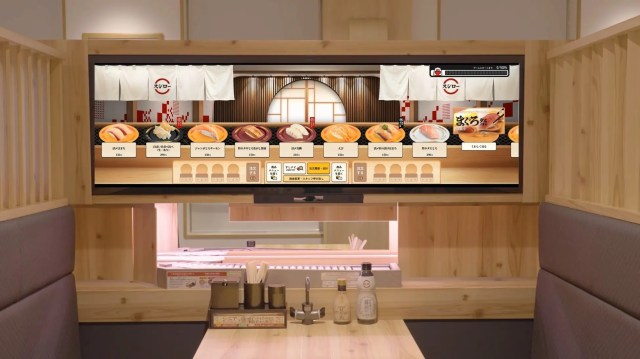

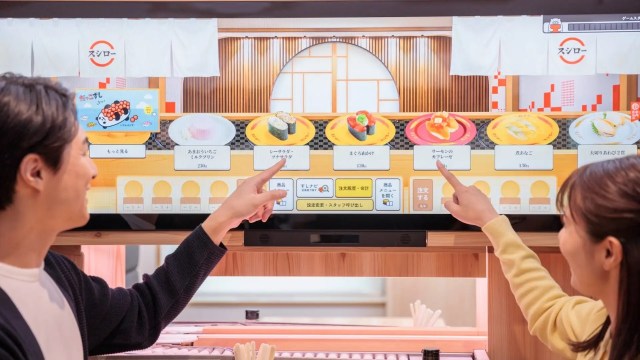
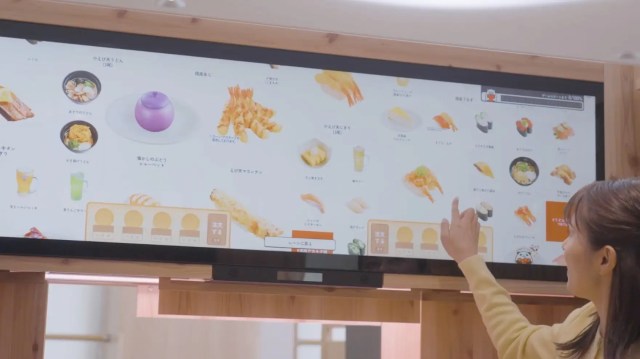
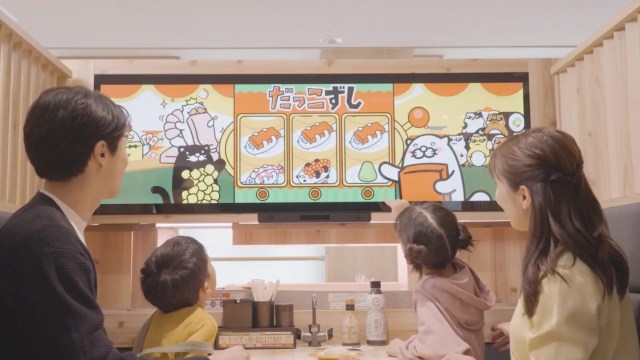
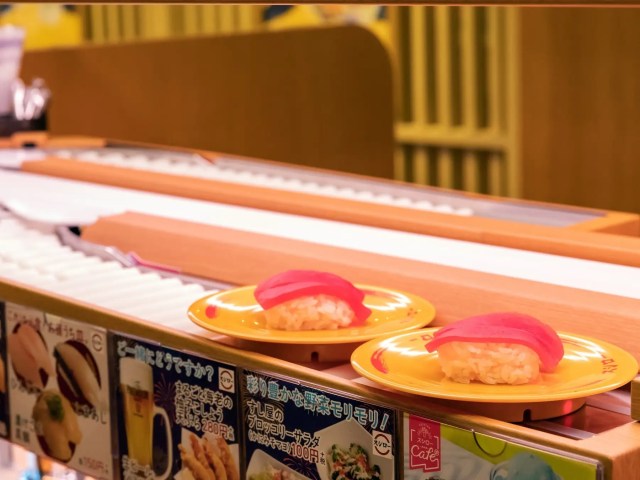
 Conveyor belt sushi chain taking the bold, eco-friendly step of getting rid of all its conveyors
Conveyor belt sushi chain taking the bold, eco-friendly step of getting rid of all its conveyors Revolving sushi chain Choshimaru’s sushi will no longer revolve in response to “sushi terrorism”
Revolving sushi chain Choshimaru’s sushi will no longer revolve in response to “sushi terrorism” Which Japanese conveyor belt sushi chain has the best tuna sushi?【Taste test】
Which Japanese conveyor belt sushi chain has the best tuna sushi?【Taste test】 This restaurant’s US$0.45 sushi is an amazing way to expand your sushi horizons in Tokyo
This restaurant’s US$0.45 sushi is an amazing way to expand your sushi horizons in Tokyo Which Japanese conveyor belt sushi chain has the best scallop sushi?【Taste test】
Which Japanese conveyor belt sushi chain has the best scallop sushi?【Taste test】 Foreigner’s request for help in Tokyo makes us sad for the state of society
Foreigner’s request for help in Tokyo makes us sad for the state of society Japanese city loses residents’ personal data, which was on paper being transported on a windy day
Japanese city loses residents’ personal data, which was on paper being transported on a windy day Seaside scenery, history, and so many desserts on Yokohama’s Akai Kutsu【Japan Loop Buses】
Seaside scenery, history, and so many desserts on Yokohama’s Akai Kutsu【Japan Loop Buses】 Ghibli Park now selling “Grilled Frogs” from food cart in Valley of Witches
Ghibli Park now selling “Grilled Frogs” from food cart in Valley of Witches Historical figures get manga makeovers from artists of Spy x Family, My Hero Academia and more
Historical figures get manga makeovers from artists of Spy x Family, My Hero Academia and more Suntory x Super Mario collaboration creates a clever way to transform into Mario【Videos】
Suntory x Super Mario collaboration creates a clever way to transform into Mario【Videos】 Akihabara pop-up shop sells goods made by Japanese prison inmates
Akihabara pop-up shop sells goods made by Japanese prison inmates Japan’s massive matcha parfait weighs 6 kilos, contains hidden surprises for anyone who eats it
Japan’s massive matcha parfait weighs 6 kilos, contains hidden surprises for anyone who eats it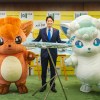 New adorable, two-color Vulpix airplane will take you to Hokkaido, not even for a limited time
New adorable, two-color Vulpix airplane will take you to Hokkaido, not even for a limited time Japan removes tour guide requirement for foreign tourists
Japan removes tour guide requirement for foreign tourists McDonald’s new Happy Meals offer up cute and practical Sanrio lifestyle goods
McDonald’s new Happy Meals offer up cute and practical Sanrio lifestyle goods Japanese ramen restaurants under pressure from new yen banknotes
Japanese ramen restaurants under pressure from new yen banknotes French Fries Bread in Tokyo’s Shibuya becomes a hit on social media
French Fries Bread in Tokyo’s Shibuya becomes a hit on social media Studio Ghibli releases new action figures featuring Nausicaä of the Valley of the Wind characters
Studio Ghibli releases new action figures featuring Nausicaä of the Valley of the Wind characters New private rooms on Tokaido Shinkansen change the way we travel from Tokyo to Kyoto
New private rooms on Tokaido Shinkansen change the way we travel from Tokyo to Kyoto Red light district sushi restaurant in Tokyo shows us just how wrong we were about it
Red light district sushi restaurant in Tokyo shows us just how wrong we were about it Tokyo Tsukiji fish market site to be redeveloped with 50,000-seat stadium, hotel, shopping center
Tokyo Tsukiji fish market site to be redeveloped with 50,000-seat stadium, hotel, shopping center All-you-can-drink Starbucks and amazing views part of Tokyo’s new 170 meter-high sky lounge
All-you-can-drink Starbucks and amazing views part of Tokyo’s new 170 meter-high sky lounge Beautiful Ghibli sealing wax kits let you create accessories and elegant letter decorations【Pics】
Beautiful Ghibli sealing wax kits let you create accessories and elegant letter decorations【Pics】 Studio Ghibli releases Kiki’s Delivery Service chocolate cake pouches in Japan
Studio Ghibli releases Kiki’s Delivery Service chocolate cake pouches in Japan New definition of “Japanese whiskey” goes into effect to prevent fakes from fooling overseas buyers
New definition of “Japanese whiskey” goes into effect to prevent fakes from fooling overseas buyers Our Japanese reporter visits Costco in the U.S., finds super American and very Japanese things
Our Japanese reporter visits Costco in the U.S., finds super American and very Japanese things Studio Ghibli unveils Mother’s Day gift set that captures the love in My Neighbour Totoro
Studio Ghibli unveils Mother’s Day gift set that captures the love in My Neighbour Totoro More foreign tourists than ever before in history visited Japan last month
More foreign tourists than ever before in history visited Japan last month New Pokémon cakes let you eat your way through Pikachu and all the Eevee evolutions
New Pokémon cakes let you eat your way through Pikachu and all the Eevee evolutions Sales of Japan’s most convenient train ticket/shopping payment cards suspended indefinitely
Sales of Japan’s most convenient train ticket/shopping payment cards suspended indefinitely Sold-out Studio Ghibli desktop humidifiers are back so Totoro can help you through the dry season
Sold-out Studio Ghibli desktop humidifiers are back so Totoro can help you through the dry season Japanese government to make first change to romanization spelling rules since the 1950s
Japanese government to make first change to romanization spelling rules since the 1950s Ghibli founders Toshio Suzuki and Hayao Miyazaki contribute to Japanese whisky Totoro label design
Ghibli founders Toshio Suzuki and Hayao Miyazaki contribute to Japanese whisky Totoro label design Doraemon found buried at sea as scene from 1993 anime becomes real life【Photos】
Doraemon found buried at sea as scene from 1993 anime becomes real life【Photos】 Tokyo’s most famous Starbucks is closed
Tokyo’s most famous Starbucks is closed One Piece characters’ nationalities revealed, but fans have mixed opinions
One Piece characters’ nationalities revealed, but fans have mixed opinions We asked a Uniqlo employee what four things we should buy and their suggestions didn’t disappoint
We asked a Uniqlo employee what four things we should buy and their suggestions didn’t disappoint Princesses, fruits, and blacksmiths: Study reveals the 30 most unusual family names in Japan
Princesses, fruits, and blacksmiths: Study reveals the 30 most unusual family names in Japan Which Japanese conveyor belt sushi chain has the best salmon sushi?【Taste test】
Which Japanese conveyor belt sushi chain has the best salmon sushi?【Taste test】 Sharpen your sushi-selecting skills with the High Speed Sushi-Go-Round Quiz! 【Videos】
Sharpen your sushi-selecting skills with the High Speed Sushi-Go-Round Quiz! 【Videos】 Which Japanese conveyor belt sushi chain has the best squid sushi?【Taste test】
Which Japanese conveyor belt sushi chain has the best squid sushi?【Taste test】 Japan’s Sushiro revolving sushi chain stops revolving with conveyor-less food court branch
Japan’s Sushiro revolving sushi chain stops revolving with conveyor-less food court branch Sushi-delivering robots to go into operation in Japan next month
Sushi-delivering robots to go into operation in Japan next month Put down the soy sauce! We try a new “expert” way to season your sushi【Taste test】
Put down the soy sauce! We try a new “expert” way to season your sushi【Taste test】 Can’t go to conveyor belt sushi? Major Japanese chain will bring the conveyor belt to you!
Can’t go to conveyor belt sushi? Major Japanese chain will bring the conveyor belt to you! Which Japanese conveyor belt sushi chain has the best yellowtail sushi?【Taste test】
Which Japanese conveyor belt sushi chain has the best yellowtail sushi?【Taste test】 Kappa Sushi rents out conveyor belt for diners to use at home
Kappa Sushi rents out conveyor belt for diners to use at home Japanese revolving sushi restaurant chain stops revolving during coronavirus outbreak
Japanese revolving sushi restaurant chain stops revolving during coronavirus outbreak What time of day gets you the best-tasting sushi at a revolving sushi restaurant?
What time of day gets you the best-tasting sushi at a revolving sushi restaurant? Which Japanese conveyor belt sushi chain has the best bintoro sushi?【Taste test】
Which Japanese conveyor belt sushi chain has the best bintoro sushi?【Taste test】 Sushi tacos now on sale in Japan — Can this cross-cultural cuisine please our biggest taco fan?
Sushi tacos now on sale in Japan — Can this cross-cultural cuisine please our biggest taco fan? Which Japanese conveyor belt sushi chain has the best saltwater eel sushi?【Taste test】
Which Japanese conveyor belt sushi chain has the best saltwater eel sushi?【Taste test】 Which Japanese conveyor belt sushi chain has the best negitoro sushi?【Taste test】
Which Japanese conveyor belt sushi chain has the best negitoro sushi?【Taste test】 Which Japanese conveyor belt sushi chain has the best egg sushi?【Taste test】
Which Japanese conveyor belt sushi chain has the best egg sushi?【Taste test】
Leave a Reply